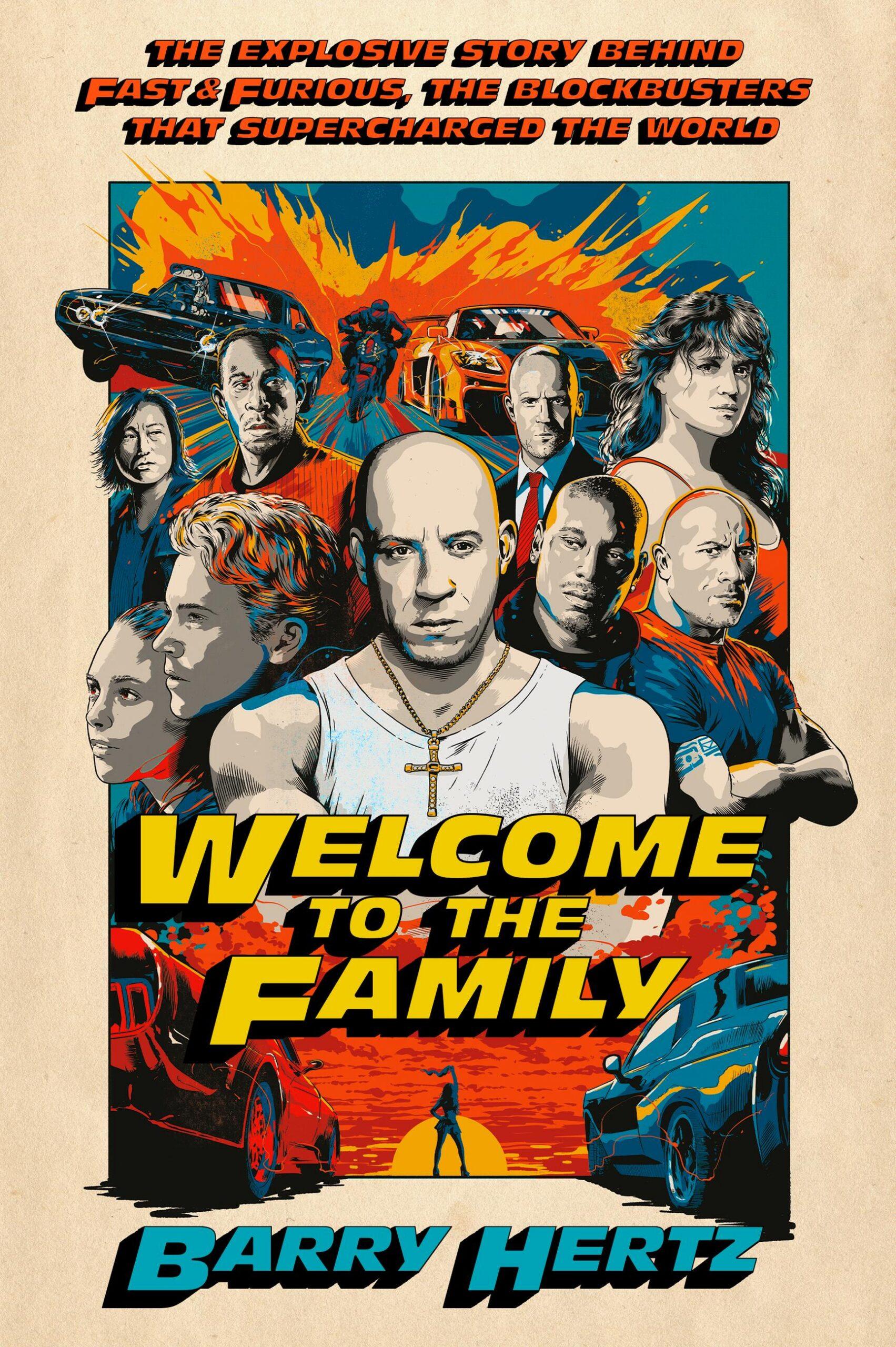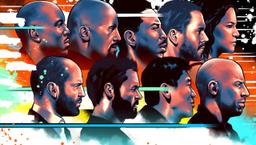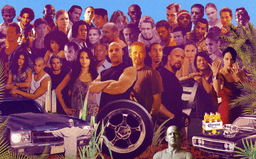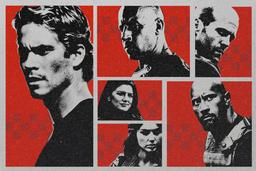This week marks 12 years since Paul Walker’s death in a single-vehicle collision in 2013. At the time of his death, production was underway on Furious 7—although the fatal car crash occurred off set—and the team behind the beloved franchise was rocked. In his new book, Welcome to the Family: The Explosive Story Behind Fast & Furious, the Blockbusters that Supercharged the World, out Tuesday, Barry Hertz chronicles the development of one of Hollywood’s biggest (and strangest) franchises. In this exclusive excerpt, Hertz looks back on the Furious 7 cast and crew’s immediate reaction to the news of Walker’s death and how they ultimately decided on Brian O’Conner’s send-off.
You could hear the crash—an awful crunch of metal and glass followed by an explosive boom—several blocks away. But no amount of terrible, violent noise could prepare you for the sight of the scene itself: a Porsche Carrera GT mangled beyond recognition, its smoldering carbon-fiber husk wrapped around a concrete post, black smoke choking what moments before had been a clear autumn sky. It was the cruel result of what happens when a notoriously hard-to-control sports car goes more than 80 miles per hour and suddenly spins out, slamming into its surroundings. The impact of the curb, the trees, a light pole. And then flames.
It was just after 3:30 p.m. on November 30 in Santa Clarita, Calif., and Paul Walker was dead.
Just minutes before, everything in the actor’s world had seemed perfect—the long holiday weekend that he wanted. Back home in California with his family for Thanksgiving after taking a break from filming Furious 7, the seventh installment in his long-running Fast & Furious franchise, Walker had been wrapping up a successful toy drive at the offices of Always Evolving, the automotive performance shop he had cofounded with fellow gearheads Erik Davis and Roger Rodas. The holiday-timed charity event was held by Walker’s Reach Out WorldWide organization to send toys to survivors of Typhoon Haiyan in the Philippines, the invitation urging donors to help “economically disadvantaged children from around the world” who “are faced with the same dilemma year after year; the lacking of joy and cheer.”
After the event wound down, Walker was set to meet his teenage daughter Meadow, his mother, Cheryl, and his brothers, Caleb and Cody, to decorate the family Christmas tree. But before he left, the actor hopped into the passenger seat of the Carrera GT, with Rodas behind the wheel, presumably for a quick ride around the office park. The two sped off. Minutes later, a crash echoed throughout the industrial area, sparking panic and confusion. Employees rushed from the Always Evolving offices to discover the wreckage. One bystander, a stuntman and friend of Walker named Newton Wimer, had to be physically wrestled away from the scene with burns on his arms after trying in vain to pull Walker and Rodas from the blazing car. There was nothing to be done. The two were gone in an instant.
“I was on a motorcycle race with my son when I got the call. We just happened to be close to Cheryl’s house. Twenty minutes later, I was there with Meadow,” says Oakley Lehman, Walker’s longtime friend and stunt double, who had planned to meet up with Walker that weekend at the actor’s Carpinteria ranch. “It was the hardest time ever.”
News of the tragedy quickly pinged back and forth among the Fast cast and crew. “I was on a plane at the time, and the moment I stepped off, I had 80 voicemails from everybody on the crew, everyone who had ever worked on a Fast & Furious movie. I remember where I was and what I was doing when I got the news more than when 9/11 happened,” says Dylan Highsmith, an editor on Furious 7. “This was just one of those moments that was surreal—everything just stops.”

While word made its way around the Fast family, headlines began to appear online and rumors began to spread. Had Rodas and Walker been racing another car? Had anyone been high or drunk? How could it have happened? Why had it happened? In due time, police would determine that the cause of the solo-vehicle collision had been “unsafe speed for the roadway conditions.” Both Walker and Rodas had been wearing seat belts. Neither had drugs or alcohol in his blood. But the Porsche, which was rarely driven outside the showroom Walker and Rodas shared, had tires that were more than nine years old. At the time of the crash, Rodas was driving between 80 and 93 miles per hour. The posted speed limit was 45 miles per hour. That was that.
At the time, many people refused to believe the news; it must’ve been a cruel joke, a hoax. “Why Paul, one of the best people, to have God call him home?” recalls Rob Cohen, who directed Walker in the first Fast & Furious film. “It was painful.”
A few days after the accident, Walker’s longtime Fast costar Vin Diesel showed up at the crash site, where fans had begun to congregate, and picked up a police patrol car’s speaker to make an impromptu speech: “If my brother were here right now and saw all the love that you’re bringing here, if he could see for himself that all of you have showed up to show my brother love at this hard time. . . . It’s going to stay with me forever.”
While the rest of the world was mourning, Universal Pictures had to balance grief with corporate strategy.
On December 1, the morning after the crash, the studio’s top brass held a conference call to determine the next steps to take with Furious 7, which was barely half done shooting. Ron Meyer, the vice chairman of NBC Universal, tasked himself with one of the most painful experiences of his career: making condolence calls to the Walker family, to every member of the Fast cast, to agents, managers, and dozens of other key production personnel. Studio chairman Donna Langley, having recently ascended to the job after her boss, Adam Fogelson, had been pushed out just two and a half months before, joined forces with executive Jeff Kirschenbaum to comb through the film’s script and footage to figure out just where production stood and how things might or might not move forward. Jeff Shell, the newly appointed chairman of Universal Filmed Entertainment Group, sorted out the legal questions regarding any delay or shutdown in production. And studio president Jimmy Horowitz dived into matters regarding contracts and suspension pay.
“It was a terrible, terrible weekend,” recalls Nikki Rocco, Universal’s longtime president of distribution. “We just weren’t sure what was going to happen.”
The process was both simple and fraught. Nothing could be decided about Furious 7 until Universal executives could assure themselves that there was some possible way to finish the production. How much footage had Walker shot? How could the story be rewritten to accommodate his absence? And then, if production could in fact resume, how much of a risk would jerry-rigging such a production be in terms of the long-term value of the brand? Would going forward, in any fashion, upset Walker’s family, his castmates, his fans? Skepticism inside and outside Universal ran high.
“Everyone else was put on hold, but for us the pressure was on to find whatever we could—and this was before they even knew how the storyline was going to change to adapt and make it plausible,” recalls editor Leigh Folsom Boyd. “We hadn’t at that point shot anything of Paul in a car, because they traditionally hold those shoots till the end of the production, when it’s just actors against blue screen. So that stuff was still outstanding, which is a huge chunk of any Fast & Furious movie.”
As the Christmas holidays approached, the studio brass convened the film’s VFX team. “I don’t think I would normally be in those kinds of high-level meetings except for the fact that I’m in visual effects, right? So we’re all around the table, and it was decided we had to take a step back, let the family grieve, let everybody grieve, and really take our time to figure out what path to take,” recalls visual effects producer Karen M. Murphy, an industry veteran who has worked on everything from Titanic to The Matrix. “You think of the movie business as all about money, but Universal really wanted to do the right thing. And they weren’t going to do it if the family wasn’t on board.” It didn’t take long for Walker’s family—Cheryl especially—to approve the idea of finishing the film. They thought Paul would want it that way. “That’s when we got to work evaluating what kind of movie we had, what the missing pieces were,” says Murphy. “If his mom wants this movie done, I’m in, right?”
Mike Wassel, the series’ longtime VFX production supervisor, who oversaw all the various digital effects vendors required to make a Fast film what it was, examined a few different approaches. “We didn’t have digital scans of Paul for this film yet, but we did have scans of him from previous shows. So we had a lot of data and a lot of photography; there was a multipronged approach we could take to recreating his likeness for the remainder of the film,” he recalls. “Then the sequences could be rewritten to accommodate less of a need for Paul to be on camera. And it helped that from the previous Fast movies, Paul’s look was fairly consistent from film to film. But we’re trying to recreate the oldest version of Paul. This was something of a complete R&D exercise.”
A handful of new endings were considered, including one in which Brian is involved in a car crash, the character’s fate left unclear. But that was quickly deemed insensitive and never filmed; the real-life circumstances of Walker’s death required an extraordinarily delicate approach. He was the famous star of a franchise built on the rush of speed who had been killed in an accident in which speed had been the primary factor. Walker’s death was not a Brandon Lee or Vic Morrow or Halyna Hutchins type of situation, where an on-set stunt goes fatally awry; it was an almost direct echo of the live-fast-die-young tragedy of James Dean, this time amplified exponentially by a TMZ-fueled news cycle that lived and breathed the fumes of the tragedy for months.
The line between Walker’s reality and the Fast-verse fantasy was inextricably blurred. The first time we see Brian’s character in The Fast and the Furious is when he’s driving his Eclipse in front of Dodger Stadium, catching his breath after recklessly speeding around the lot. Then in 2 Fast 2 Furious, he crashes his Skyline after a run-in with the cops. Even at one point in Furious 7, he is the passenger in a cherry red luxury sports car that spins out before exploding—just as Walker himself was the passenger in a cherry red luxury sports car during his explosive fatal accident. Nobody wanted to say it out loud at the time, but the circumstances of Walker’s last ride went directly against all the many public safety advisories pasted onto the end of the Fast films: “The motor vehicle action sequences depicted in this film are dangerous. No attempts should be made to duplicate any action, driving or car play scenes herein portrayed.”
How could Furious 7 director James Wan and screenwriter Chris Morgan respectfully acknowledge the context of their star’s death without undermining the rule-breaking thrills—the illicit danger—that the entire franchise was built on? “Pretty early on after they decided that they were going to go through with finishing the film, Chris Morgan pitched us in the cutting room the tasteful ending of just having Brian say goodbye to Dom and the road splitting into two. You could hear a pin drop when he was talking,” recalls Highsmith. “Everyone just knew that this was the right way to end the movie, the right thing to do. We all wanted to give 110 percent. How do we help ourselves and the audience say goodbye? It became a different beast.”
But to make it all happen, the Fast team would not only have to recruit the top visual effects experts in the world; they would need to call on family, too.
Excerpted from Welcome to the Family: The Explosive Story Behind Fast & Furious, the Blockbusters that Supercharged the World. Copyright 2025 by Barry Hertz. Reprinted with permission of Grand Central Publishing. All rights reserved.



